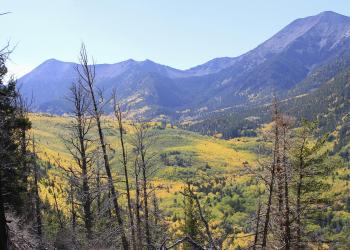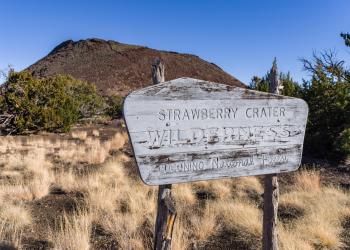Wilderness
Welcome to the wild. Designated Wilderness Areas reflect the character and concept of a place set aside to preserve natural conditions, provide opportunities for solitude and primitive recreation, and to protect cultural, ecological and historical values.
Wilderness Areas were established following the Wilderness Act of 1964.
There are 10 different Wilderness Areas (all or part of) located on the Coconino National Forest.
Visitors to Wilderness Areas are reminded to practice Leave No Trace principles. Dispose of waste properly, leave what you find, respect wildlife, abide by fire restrictions when in effect, and be considerate of other people and public lands.
Wilderness Areas
Fossil Springs Wilderness
Fossil Springs Wilderness is a 11,550-acre Wilderness Area that sustains more than 30 species of trees and shrubs, and more than 100 species of birds.
The Fossil Creek Wild and Scenic River runs through the middle of the Wilderness Area, which spans both the Coconino and Tonto national forests.
Kachina Peaks Wilderness

The 18,960-acre Kachina Peaks Wilderness was established as a Wilderness Area in 1984 and is located on the Coconino National Forest's Flagstaff Ranger District.
This area offers a network of trails that lead over the rims and edges of a now-dormant volcano which last erupted roughly 2 million years ago. Visitors can trek peaks, saddles, and the mountain's inner basin: an expansive caldera that formed during the mountain's most recent volcanic cataclysm and now plays host to a thriving stand of white-barked aspen trees. This Wilderness Area contains Humphrey's Peak, the highest point in Arizona at 12,643 feet above sea level.
The Kachina Peaks Wilderness Area was heavily affected by the 2022 Pipeline Fire.
The Kachina Peaks Wilderness area is sacred to northern Arizona's indigenous people. The word "Kachina" comes from the name of the Hopi deities, which are said to fly from the top of the peaks to the Hopi mesas every summer as the clouds bring seasonal monsoon rains.
Kendrick Mountain Wilderness
The Kendrick Mountain Wilderness Area is a 6,664-acre portion of both the Coconino and Kaibab national forests that was designated as a Wilderness Area in 1984. The area includes Kendrick Peak, which reaches an elevation of 10,418 feet above sea level.
A large wildfire broke out in the Kendrick Mountain Wilderness Area in 2000 and its effects are still noticeable today.
Mazatzal Wilderness
The Mazatzal Wilderness Area predates the Wilderness Act and was established as one of the original Wilderness Areas in 1964. The 252,500 acres of the Mazatzal Wilderness Area span across both the Coconino and Tonto national forests.
The eastern side of the Mazatzal consists of brush or pine-covered mountains, broken by narrow, vertical-walled canyons. The Verde River flows through the Sonoran Desert on the western side of this Wilderness Area beneath its steep, brush-covered foothills.
Elevations range from 2,060 feet along the Verde River to 7,903 feet on Mazatzal Peak.
Munds Mountain Wilderness
The Munds Mountain Wilderness area spans a total of 18,109 acres, located entirely on the Coconino National Forest's Red Rock Ranger District.
The area's elevations range from 3,600 feet above sea level to 6,825 feet above sea level. The rugged cliffs, buttes and mesas of the Munds Mountain Wilderness Area are speckled with desert sage brush, grass, chaparral and pinyon-juniper woodlands.
Red Rock - Secret Mountain Wilderness

The 43,950 acres of the Red Rock - Secret Mountain Wilderness Area are full of stunning rosy-hued cliffs, buttes and canyons. This Wilderness Area was designated in 1984 and marks the edge of the Colorado Plateau just east of Sycamore Canyon Wilderness.
The Red Rock - Secret Mountain Wilderness Area, despite its name, is one of Arizona's most accessible Wilderness Areas. A large network of trails criss-cross the area's deep canyons and dense riparian vegetation.
Strawberry Crater Wilderness

The 10,414-acre Strawberry Crater Wilderness Area is part of the sprawling San Francisco volcanic field. Roughly 600 craters and cones — all between 50,000 and 100,000 years old — pockmark the landscape.
The cinder-topped rolling hills of the Strawberry Crater Wilderness Area range in elevation from 5,500 feet to 6,000 feet and are dotted with pinyon and juniper trees.
Sycamore Canyon Wilderness

The 58,448-acre Sycamore Canyon Wilderness Area was designated as a wilderness area in 1972. The colorful cliffs, soaring pinnacles and desert plains are overseen by four separate ranger districts on three national forests: The Coconino, the Kaibab and the Prescott.
Many creatures — including black bears, mountain lions, ringtail cats, javelina, canyon wrens and hermit thrushes — call the Sycamore Canyon Wilderness Area home. Visitors can expect to see lush riparian areas throughout the area as Summer Spring and Parsons Spring feed into Sycamore Creek. Leafy trees and plants put on a colorful show each fall here in Arizona's second-largest canyon.
West Clear Creek Wilderness
The 15,465-acre West Clear Creek Wilderness Area is a narrow but lengthy wilderness area that follows the contours of West Clear Creek from its western terminus at Bull Pen Ranch to the headwaters of Willow and Clover creeks to the north and east. The deep, narrow, rugged and spectacular canyon was established as a wilderness area in 1984 and offers a wide range of vegetation and geology due to the variances in elevation and sunlight across the steep canyon walls.
Wet Beaver Wilderness
The Wet Beaver Wilderness is a small Wilderness Area at 6,184 acres, but visitors have much to see in the winding steep-walled canyon that surrounds a perennially flowing desert stream. The Wet Beaver Wilderness's riparian habitat is home to elk, deer, bears, lions, reptiles and birds.
More Information
Prospecting and treasure troving activities occur in Wilderness Areas of the Coconino National Forest.
Some of these activities are described briefly below.
For further information on these activities including regulations and necessary permits, contact local the Forest Service Office that administers the area of interest.
Prospecting
Prospecting is the gathering of information on mineral resources. Prospecting is allowed within a designated Wilderness Area, but an approved Plan of Operations is required. No person can acquire any right of interest to mineral resources discovered by prospecting or other information-gathering activity. Extraction of minerals (except a small grab sample) is a type of mining, and must comply with all related laws and regulations; see "Mining" (next subject). If the search is for precious worked metal or other treasure, see "Treasure Trove Hunting" below.
Mining
Mining is any activity that attempts to extract minerals (which are valuable and locatable) from their natural setting. No mining of any type (whether for recreation and/or profit) is allowed except with an approved Notice of Intent and/or Plan of Operations for activity on a legal claim with valid existing rights. New mining claims can no longer be filed on designated Wilderness Areas. The Wilderness Act of 1964 allowed mining claims to be filed until January 1, 1984, at which time all Wilderness Areas were closed to new mineral entry. Subsequently- designated Wilderness Areas were closed to mineral entry upon enactment of the law creating them.
Gold Panning
This category includes panning, sluicing, or dredging wet or dry material. If any mineral is extracted by this activity (for recreation and/or profit), it is a type of mining; see "Mining" above. If mineral is not extracted, this activity would be a type of prospecting; see "Prospecting" above.
Metal Detecting
If the metal detector is used to search for and/or extract locatable minerals, the activity is considered either a form of prospecting or mining; see "Prospecting" and "Mining" above. If the search is for money (except recent vintage coins), or precious worked metal, see "Treasure Trove Hunting" below. If the search is for recent vintage coins, no permit is needed so long as there is no significant soil disturbance.
Treasure Trove Hunting
A treasure trove is defined as money, gems, or precious worked metal (in the form of coins, plate, bullion, etc.) of unknown ownership. Not included are recent vintage coins, locatable minerals, or archeological resources and specimens. Searching for such treasure must be authorized by a permit. Applications for Treasure Trove Permits are evaluated on a case-by-case basis; approval requires that evidence of treasure is of such a character that a person of ordinary prudence would be justified in the expenditure of labor and funds, with a reasonable possibility of success. Permits are issued for a specific number of days and the site is subject to inspection.
What is Wilderness?
Learn more about Wilderness Areas, their history, and The Wilderness Act of 1964 via our Washington Office.



